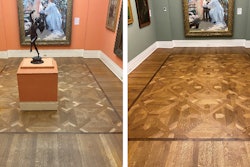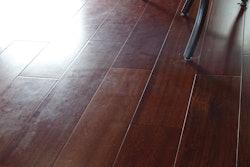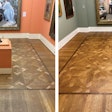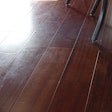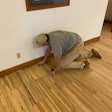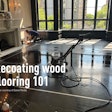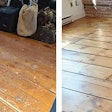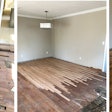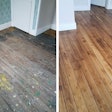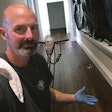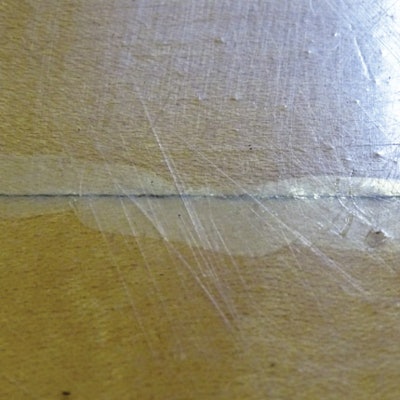
So you have a call for a maintenance coat. There is good money to be made recoating hardwood floors, but with good money comes high risks: customer expectations and adhesion! If all goes well, everyone walks away from the process happy. However, the alternatives can be sanding and refinishing or even replacing a floor. To avoid those not-so-fun alternatives, we need to do our due diligence before applying any finish. These are the steps we use at my company to avoid surprises with recoats.
Step 1: Determine if it’s a candidate for a recoat.
Is it wax? Oil? Some flooring has finish with a very specific protocol for recoating. If the finish can be recoated, has something been used to clean the floor that has created a buildup and will cause an adhesion problem? You must confirm compatibility before doing a recoat. Wait … read that sentence again. You must confirm compatibility before doing a recoat. This is the key to success in the recoating portion of your business.
Step 2: Educate the customer about the risks.
The customer must understand the risks involved with a recoat. The floor must be tested for adhesion with a finish system, and the system must be strictly adhered to. Not all floors will be candidates for a recoat. If at any time you feel that the system you are using is going to fail, listen to your gut and STOP. You will never lose money on a job you don’t do.
It is a good idea to have the customer sign your contract stating they understand the risks involved and understand that, even with all of the testing and the best finishes, the coating could fail and the floor may need to be sanded and refinished. We do this, and we also offer them 50 percent off the cost of the recoat as a down payment toward a sand-and-finish. Our contract states this; it sometimes scares the customer, and it should. This is when you explain to the customer everything they could expect. I have only had to implement the 50 percent off offer once, and the customers were thankful I had something in place to help them out.
Step 3: Educate the customer about realistic expectations.
This may not seem like a huge part of the recoating process, but it is. Many times the customer is under the assumption a recoat will fix all of the imperfections and distress present on their wood floor. Recoats fix everything, right? This needs to be thoroughly explained to them. It is your job to educate your customer—don’t rely on the internet. They need to understand deep scratches and dents will still be present. A recoat will fix many scuffs and surface damage, but any scratch that can be felt by running your fingernail on the surface of the wood will still be present after recoating. Do not ever sell them on perfection if you are going to be unable to produce perfection. Not all floors will be candidates for a recoat—some should be sanded and refinished.
RELATED: The Recoating Riddle: Find the Right Clues When Recoating Wood Floors
Another thing I have found is that customers often expect the floor to be shinier after a recoat. If the floor has a satin sheen and you recoat with satin, the floor may not look much different. Explain this to them! If you have explained the benefits and the purpose of the recoat in the beginning, this will never be an issue. The purpose of a recoat is to maintain the condition of the floor and to add a layer of finish to the surface to protect the floor from normal wear and tear. In other words, it is Botox, not a facelift! It is important to explain all aspects of your work and to build good relationships with your customers; this is what will earn their trust and earn you additional jobs.
Step 4: Test adhesion.
Once the customers understand the risks and the expected outcome of the recoat, and they have agreed to a price, it is time to check the most important part of the recoating process: adhesion. This is where the majority of recoats fail. There are a variety of recoating systems out there. I say “systems” because most of the products recommended for recoats have a very specific set of steps in order for their products to work. They are specific about abrasion, dry times, cleaners used, and the list goes on. Find one you are comfortable with and use it exactly as stated by the manufacturer.
It is imperative you use exactly the same process for the test location as you do for the actual recoat. Do not cut corners on dry times for a cleaner or bonding agent. Choose a location to test that has received all of the abuses and cleaning products the floor may have encountered, not a location under a rug or in a closet. Find one in the kitchen or maybe in a major traffic area, like a hall. It is not uncommon to have to do multiple locations, and I highly recommend it.
Once you have found your test location(s) and applied the finish system, it is time for the drum roll. This is the point where you try to make the floor finish system fail. There are two test methods, A and B, and both fall under ASTM 3359 for finish adhesion testing. The results are rated on a scale from 5A-0A, with a 5A being no peeling and 0A being failure well beyond the test section. Check with your finish manufacturer as to which test they want you to use.
RELATED: Recoating Prefinished Wood Floors Doesn't Have to Be a Gamble
Step 5: Prep your floor.
Finally, if you have educated your customer and the test locations performed well, it is time for the actual recoat. The only advice I have after this point is: prep, prep, prep your floor. You can never have your floor prepped well enough. Most of the time by this point our work is 90 percent prep and 10 percent finish work. (This is true for almost everything in life.) Spend the time and make sure your floor is free of all debris prior to any finish application. Once the finish is down, we have just sealed that debris in the floor.
Don’t be afraid of recoats. Embrace the opportunity—just make sure you protect yourself and your customers by doing your due diligence. If you take care of your customers and don’t cut corners, you will build a reputation that will work better than any advertising!
















